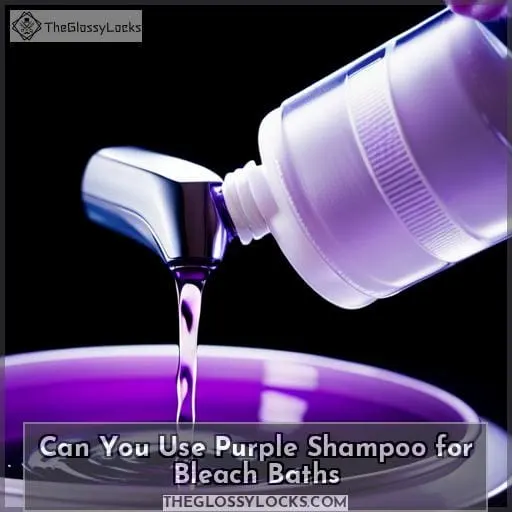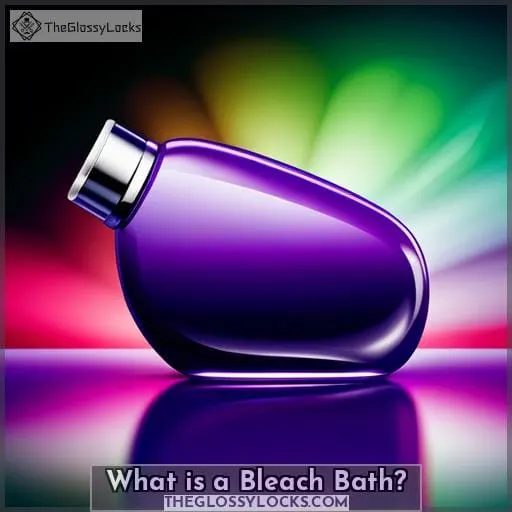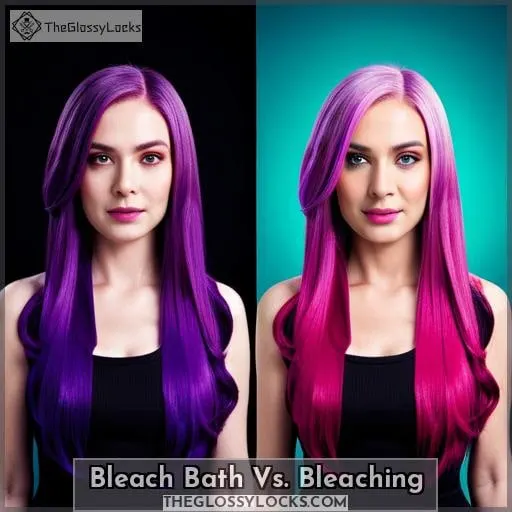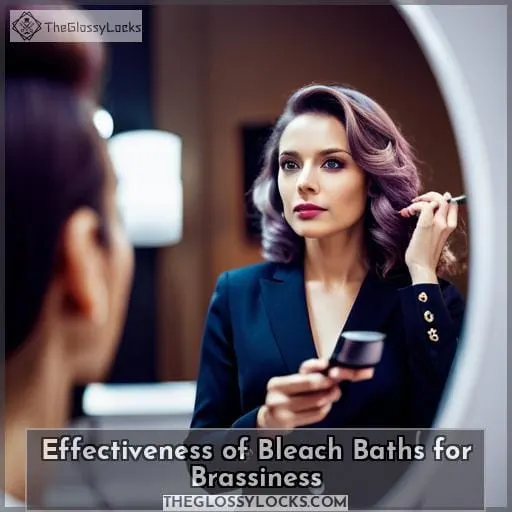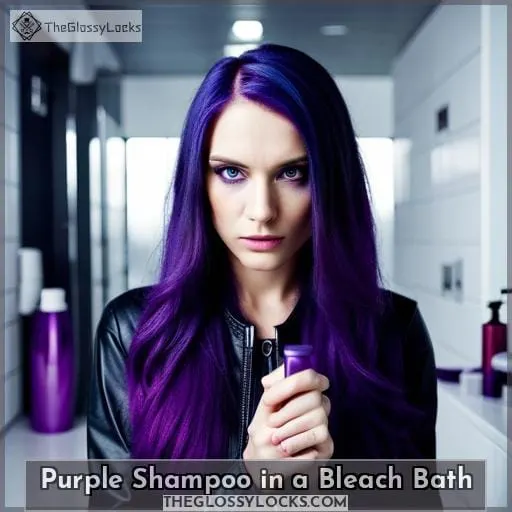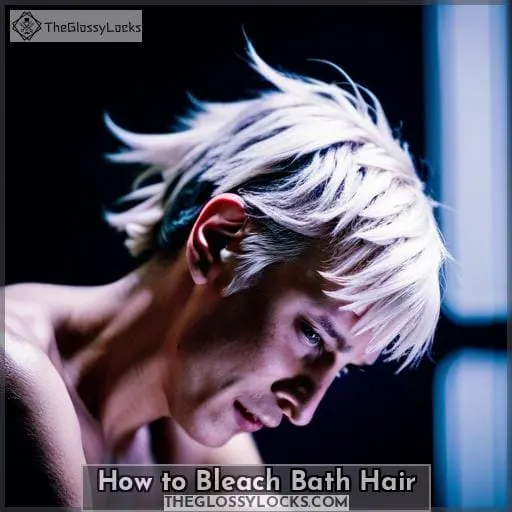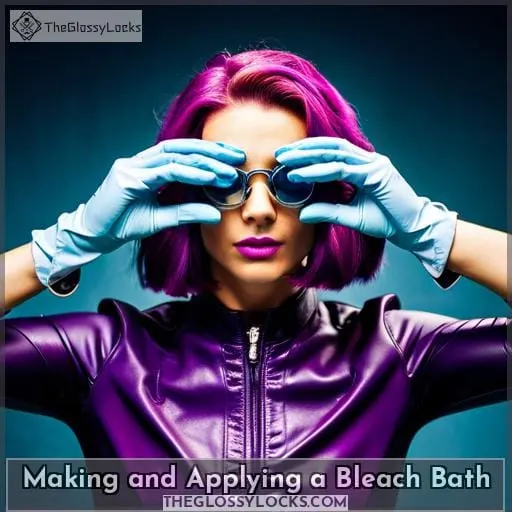This site is supported by our readers. We may earn a commission, at no cost to you, if you purchase through links.
Hey there! Are you looking for a way to lighten your hair without the full-blown damage of regular bleaching? If so, then bleach baths could be just what you’re after. This method of gradually lightening your hair is becoming increasingly popular, and it involves using purple shampoo as part of the process.
But can purple shampoo really work in a bleach bath? In this article, we explore what exactly is involved in this procedure and how effective it can be when trying to achieve that desired color.
Table Of Contents
Key Takeaways
- Purple shampoo can be used in a bleach bath to help achieve the desired color.
- Bleach baths cause less damage compared to other bleaching techniques.
- Adding coconut oil to the mixture can protect against orange tones.
- Purple shampoo counteracts yellow tones in blonde hair and provides deep conditioning benefits.
What is a Bleach Bath?
A bleach bath is a type of hair treatment that can help restore color and shine to your locks. It involves using diluted bleach mixed with shampoo or conditioner, which is then applied directly onto the hair.
The process usually takes about 15 minutes, depending on how light or dark you want your hair to be.
Bleach baths are often used by people who have already dyed their hair but want it lighter without having to use more dye. However, there are both pros and cons associated with this technique that must be considered before attempting it yourself at home.
One of the main advantages of opting for a bleach bath over traditional bleaching methods is that they tend to cause less damage since only small amounts of product come in contact with the scalp and strands.
Additionally, if done correctly (which means wearing protective gloves when mixing/applying), these baths can leave behind beautiful results while also being gentle enough not to strip away all existing color from previous dyes used prior.
However, despite its many benefits, there still remain some dangers associated with taking part in a DIY bleach bath project. This is mainly because improper application could lead to permanent discoloration/burns along the scalp area.
Additionally, even after successful completion of the step, don’t forget to take extra precautions afterwards too. Apply a deep conditioning mask every week to protect strands against further breakage, and never skip out on trimming split ends regularly to keep everything healthy and shiny in the long term.
There are alternative options available too for anyone interested in going down this route. Such options include using semi-, demi-, or ultra-permanent dyes instead of regular ones to achieve the desired result safely and cost-effectively, with no risk of damaging the delicate structure of each individual follicle.
Bleach Bath Vs. Bleaching
You may be wondering what the difference is between a bleach bath and regular bleaching techniques, so let’s compare them!
A bleach bath uses diluted bleach mixed with shampoo or conditioner that is applied directly onto the hair. This chemical process helps to remove existing color from previous dyes as well as lighten strands of hair without causing too much damage.
Regular bleaching involves using stronger concentrations of products such as peroxide, which can strip away pigment faster but also cause more harm in terms of breaking down proteins found naturally within each follicle when exposed for too long at once.
The main benefit to opting for a bleach bath over traditional methods is that it takes less time and has fewer risks associated with it because only small amounts are used during application – thus resulting in less potential damage being done overall compared to other coloring services like highlights or balayage treatments where large sections may need processing multiple times throughout one session alone!
Additionally, you can add coconut oil into your mixture if desired since this will help protect against any orange tones that might appear afterwards due to excessive heat exposure while drying out locks post-treatment; just make sure not to use brands known specifically for their highly concentrated levels before starting any treatment like this one though!
Overall, both processes have their own advantages depending on what type of look you’re after – whether it’s lighter blonde shades quickly achieved through strong bleaches or softening previously colored tresses gradually via more gentle baths.
Effectiveness of Bleach Baths for Brassiness
A bleach bath can be an effective way to get rid of brassiness and restore a vibrant hue, as demonstrated by the case of Jane who was able to bring back her natural color in just one session. Bleach baths use diluted bleach mixed with shampoo or conditioner that is applied directly onto hair strands for lightening purposes.
In terms of brightness levels, bleach baths provide gradual color lifting while still maintaining their protective layer over damaged follicles. However, they can also leave behind unwanted tones if not done properly. To avoid this problem from occurring in the first place, always consult with a professional stylist beforehand who will know exactly how long each strand should stay exposed under these chemicals before starting any treatment like this one though! Additionally, adding coconut oil into your mixture helps protect against orange hues which may appear due to excessive heat exposure post-treatment, so don’t forget about doing that either if desired results are expected at the end result-wise – no matter what type of look you’re after in general sense speaking here, folks.
Protecting treated hair afterwards is essential regardless of whichever route chosen between regular bleaching vs prescribed baths.
Purple Shampoo in a Bleach Bath
Adding some extra TLC to your bleach bath? Incorporate a purple shampoo into the mix for an even more vibrant, long-lasting color. Purple shampoos are formulated with blue and violet pigments that counteract yellow tones in blonde hair while also providing deep conditioning benefits.
This makes it ideal for those looking to maintain their newly acquired blonder hue or wanting to try out a new color without damaging their hair further through additional lightening processes.
Not only does this technique of adding purple shampoo provide color correction but can also act as heat protection from hot tools used after treatment, as well as silver toning if desired! Plus, it’s way gentler on strands than other chemical treatments due to its milder process overall too!
When using this mixture of shampoo within your bleach baths, make sure not to include any essential oils (which could cause an allergic reaction) and always proceed with caution by leaving the product in no longer than 20 minutes max so you don’t overdo it.
For best outcomes here though, folks – rinse thoroughly afterwards while avoiding any unnecessary contact between water/chemicals & skin at all times. Remember, yeah, alright, cool, you know what I mean? All things considered then, fams – incorporating purple shampoos into our usual bleaching routines is definitely worth giving consideration towards going forward, methinks indeed.
How to Bleach Bath Hair
To achieve the desired bleached look, simply blend bleach and water together for an effortless bath that will lighten your locks. A successful bleach bath is dependent on the correct mixture of ingredients – typically a combination of hydrogen peroxide and hair-bleaching agents such as potassium persulfate or ammonium persulfate.
In addition to this step, in order to discuss solutions for brassiness and comparing results between regular bleaching sessions versus those with purple shampoo added in, assess potential damage after bleaching by exploring alternatives like using argan oil which helps maintain moisture without overly stripping strands away from their natural oils, plus being gentler than other chemical treatments out there too!
Here is a list containing three key tips when conducting a bleach bath:
- Select quality products with appropriate concentrations so as not to overdo it on either end.
- Incorporating purple shampoos into our usual lightening routines can be beneficial if done cautiously and correctly.
- Use moisturizing agents such as argan oil post-treatment in order to protect against any unnecessary breakage or damage caused during the process itself.
From assessing hair damage after each session through discussing possible solutions for achieving brighter hues right down to maintaining moisture within tresses even afterwards – best shampooing practices should always remain a top priority going forward indeed ’cause you know what I mean? And while some may want more vibrant tones regardless, then following all the steps mentioned here beforehand remains essential every time, still yeah.
Making and Applying a Bleach Bath
Mixing the perfect combination of ingredients is key when crafting your own bleach bath! Whether you’re looking to lighten up your locks or just keep brassiness at bay, understanding the best option for regular bleaching of hair can really help.
When it comes to DIY solutions, purple shampoo is often recommended with caution as using too much could cause damage and dryness.
When applying this type of mixture onto tresses, however, always remember that heat styling products should also be avoided during this process so as not to create any further harm either way. Instead, opt for other methods such as air drying or towel scrunching. For an even application across all areas, particularly around the cuticles of the hair strand itself, use a wide-tooth comb.
This ensures that the product gets distributed evenly throughout without missing out on certain sections entirely.
In terms of aftercare, following these steps will give optimal results, but there’s more. Adding some hydrating agents into our routine, like argan oil, helps seal moisture back into those same long hairs which were previously exposed to harsh chemicals.
Seeing how nourishing elements play their part here, having them regularly incorporated within haircare tips becomes pretty essential if we’re aiming towards maintaining healthy, beautiful manes.
Toning Hair With Purple Shampoo
Tone up your locks with purple shampoo for a subtle shift in color – just like adding a splash of color to an artwork! Utilizing the power of purple is one way to achieve hair goals without bleaching or dyeing.
Adding this hue into haircare routines can help maintain blonde tones while also protecting from brassiness.
Unlike other lightening treatments, it doesn’t contain harsh chemicals that could strip away natural oils and damage strands.
When using any type of DIY remedy involving colors, understanding how the shades interact is an important first step towards desired outcomes. So, learning about basic principles such as complementary hues will be helpful here in order to determine what works best for us specifically when toning our manes down.
To ensure healthy hair care throughout every process involved, certain ingredients should absolutely be included within the mix. Namely, those containing keratin, which helps replace lost proteins and restore moisture balance back into tresses over time.
The modern world has made achieving beautiful looks easier than ever before, but there are still plenty of options available when coming up with homemade recipes tailored according to our own individual needs.
Rather than relying on pre-made products alone all the time, especially when it comes to blonde toners, special attention is required.
So why not try out the following mixture? Mix together 1 part purple shampoo (of choice) with 2 parts conditioner, plus a few drops of argan oil. Then, apply evenly across the scalp area, ensuring even distribution through each section using a wide-tooth comb.
Afterwards, allow it to air dry naturally or towel scrunch gently until done, rinsing off thoroughly afterward. Enjoy the newly improved look achieved through simple yet effective methods now available at your fingertips today, anytime, anywhere, conveniently right away whenever you feel like doing something extra special for yourself today.
Frequently Asked Questions (FAQs)
Is a bleach bath damaging to hair?
Yes, bleach baths can be damaging to hair. They strip away natural oils and nutrients that keep your locks healthy and vibrant. If you’re considering a bleach bath, make sure you use the right products for maximum protection against damage.
How long should a bleach bath be left on for?
You should leave a bleach bath on for approximately 5 minutes. This will help ensure that the product is effective while protecting your hair from any potential damage.
How often can I use a bleach bath?
You can use a bleach bath every two to four weeks, depending on your hair type and desired results. Conversely, if you’re looking for more subtle highlights, once a month should suffice.
Are purple shampoos safe to use in a bleach bath?
You can use purple shampoos in a bleach bath, but you should be careful. It is important to follow instructions carefully and not leave the shampoo in for too long as it could cause damage to your hair.
What is the difference between a bleach bath and bleaching?
Bleaching is a chemical process that lightens the hair by removing pigment. A bleach bath involves adding shampoo to bleaching powder and then applying it directly to your scalp for a more controlled application of the product.
It can be used on its own or with purple shampoo, depending on the desired results.
Conclusion
To summarize, bleach baths and purple shampoo can be combined to effectively reduce brassiness in hair. A bleach bath is a great way to lighten hair without the harshness of bleaching, while purple shampoo can be used to tone the hair.
When making and applying a bleach bath, it is important to follow the directions carefully and wear gloves. Once the bleach bath is applied, the hair can be toned with purple shampoo for the desired effect.
With the combination of both methods, brassiness can be minimized without causing harsh damage to the hair.

